by Catechist | 9 Jul 2018 | Catechesis, Characteristics
Characteristic #24 The Tasks of the Catechist
-
to go deeper into the Christian message through the knowledge of the biblical and liturgical sources and of ongoing living tradition of the church, including the theological, social and ecumenical movements which enliven the church today;
-
preparing an environment and maintaining order in that environment (the atrium) so that it fosters concentration, silence and contemplation in both the child and adult;
-
preparing the materials oneself as much as possible while collaborating with others in areas that are beyond one’s abilities.
Part 1
 When preparing to serve the needs of the children in the atrium, I find it helpful to remind myself of my role and task in this process. As each Catechist undergoes formation it can be a massive amount of information being received in a relatively short time. Much of this is also changing the way we have viewed working with children in our past.
When preparing to serve the needs of the children in the atrium, I find it helpful to remind myself of my role and task in this process. As each Catechist undergoes formation it can be a massive amount of information being received in a relatively short time. Much of this is also changing the way we have viewed working with children in our past.
Often adults view their role as instructor and leader. We think we have a responsibility to fill our children with the information they need to live god Christian lives. Many times this is true and for parents it is certainly a major responsibility. However, in the atrium, our role is quite different.
The adult in the atrium must be humble enough to become less and allow the child to become more. They must take on the role of servant and observer. Following carefully what the child is doing and what their next need may be to determine how they can be served.
When a child is ready or asking for a particular presentation, it is desirable that the Catechist is prepared to give it. How frustrating it would be if we were at a restaurant and order something on the menu only to be told the chef needs to practice cooking it before you can be served. The formation of the Catechist goes beyond the formal training days and must include preparing album pages and reading texts and other materials so that they are ready to give to the children.
This does not mean that we have to have every part of our presentation rehearsed or perfect, as often the children bring something to the presentation too which highlight or goes deeper into a particular aspect of the work. Instead we must be confident in the Holy Spirit working through us and using the knowledge we have received through our preparation to meet the child in their work.
The core texts for Level 1 (children from 3-6 years) are:
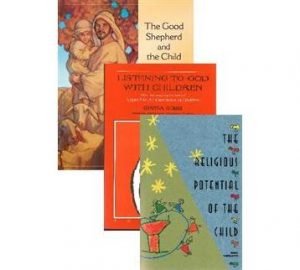
- The Good Shepherd and the Child A joyful Journey
- The Religious Potential of the Child
- Listening to God With Children
And for Level 2 and 3 (children from age 6-12 years)

- The Religious Potential of the Child 6 to 12 Years Old
- The History of the Kingdom of God: From Creation to Parousia
- The History of the Kingdom of God: Liturgy and the Building of the Kingdom
These texts give us the basic background to the children and the presentations at each level. Then we can go further by prayerful reading of Journals and other Texts available from Catechesis of the Good Shepherd and other biblical and liturgical sources. We should also be spending time in prayer and participating in the life of the Church.
Being a Catechist of the Good Shepherd becomes more of a religious calling and way of life that merely providing a service to the children. It is a blessing for the children, the parents and the catechist to be a part of this work. It is a work which calls us all ever deeper into the mysteries of Jesus, the Good Shepherd.
by Catechist | 1 Apr 2018 | Easter, Uncategorized
 The resurrection is something we recall all the time in the atrium. When we light a candle, at the altar table, in the Baptism corner, during communal prayer, we recall the light of the risen Christ, the light that is stronger than death.
The resurrection is something we recall all the time in the atrium. When we light a candle, at the altar table, in the Baptism corner, during communal prayer, we recall the light of the risen Christ, the light that is stronger than death.
In a very particular way we recognise the joy of the feast of Easter, a season that we have been waiting for, for so many weeks and will celebrate for even longer than the season of preparation, Lent. This joy is celebrated with the Liturgy of Light. Just as we do at the Easter Vigil, with the children we recall the story of Jesus death and celebrate his Resurrection. We light our Pascal candle and pray using the words from the Church’s Liturgy of Light.
Dear brothers and sisters in Christ.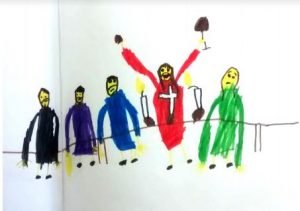
On this most sacred night,
in which our Lord Jesus Christ
passed over from death to life,
the Church calls upon her sons and daughters,
scattered throughout the world,
to come together to watch and pray.
If we keep the memorial of
the Lord’s paschal solemnity in this way,
listening to his Word and celebrating his mysteries,
then we shall have the sure hope
of sharing his triumph over death
and living with him in God.
We process into a darkened atrium and see the light grow stronger as we each light our own candle from the Pascal Candle.

May the light of Christ rising in glory
dispel the darkness of our hearts and minds.
Just as we are Baptised and filled with the light of the Risen Christ we too are called to share that light with all around us so that His light may illuminate the whole earth. And with the Easter Exsultet we too cry out with joy at the gift given to us, the gift of life forever in His kingdom. Alleluia! Alleluia!
Just as we are Baptised and filled with the light of the Risen Christ we too are called to share that light with all around us so that His light may illuminate the whole earth. And with the Easter Exsultet we too cry out with joy at the gift given to us, the gift of life forever in His kingdom. Alleluia! Alleluia!
Exult, let them exult,

the hosts of heaven, exult,
let Angel ministers of God exult,
let the trumpet of salvation
sound aloud our mighty King’s triumph!
Be glad, let earth be glad,
as glory floods her,
ablaze with light from her eternal King,
let all corners of the earth be glad,
filled with the mighty voices of the peoples.
knowing an end to gloom and darkness.
Rejoice, let Mother Church also rejoice,
arrayed with the lightning of his glory,
let the holy building shake with joy,
And with the Church we pray
May this flame be found still burning by the Morning Star;
the one Morning Star who never sets,
Christ your Son, who, coming back from death’s domain,
has shed his peaceful light on humanity,
and lives and reigns for ever and ever.
by Catechist | 10 Mar 2018 | Atrium, Catechesis
The prayer of children, particularly children under the age of 6 years, is quite different to that of the prayer of adu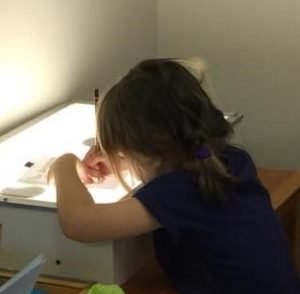 lts. It is spontaneous and includes silence and reflection. Consider a very small child silently watching an insect in the garden or concentrating intently on some task they are doing. This silent contemplation is a form of prayer. Very young children express their prayer in the joy of experiencing everything as new and wonderful. Their spoken prayer is that of thanksgiving and joy.
lts. It is spontaneous and includes silence and reflection. Consider a very small child silently watching an insect in the garden or concentrating intently on some task they are doing. This silent contemplation is a form of prayer. Very young children express their prayer in the joy of experiencing everything as new and wonderful. Their spoken prayer is that of thanksgiving and joy.
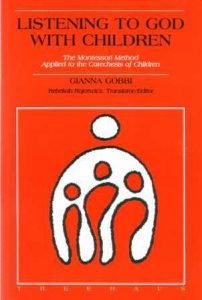 Gianna Gobbi in “Listening to God with Children” (p118) expresses it this way:
Gianna Gobbi in “Listening to God with Children” (p118) expresses it this way:
The child’s prayer can be very brief, such as “Jesus”, “Goodness”, “Light”, or “Amen” and is often followed by a long silence. Furthermore, the spontaneous prayer of the younger child is exclusively a prayer of praise and thanksgiving, rather than a prayer of petition. Thus, we hear: “Thank you for the light!” “Thank you for everything!” “Thank you because I am one of your sheep!” “Jesus is wonderful!” “My body is happy!”
This time of building their relationship with God is so beautiful and precious, we do not like to impose upon them our adult worries about the world, about our sin, our needs. We try to allow the children to continue to grow in the wonder of the new life they have been born into and grow in their natural praise and joyful thanks for all they have.
This does not mean that we neglect more formal prayer with children at this age. Through the prayers found in scripture in the prophecies and psalms, in the Infancy Narratives, the children are introduced to the language of prayer. They are in a time of their life where language is developing, and it is important for them to be exposed to the beautiful language of prayer.
“My soul magnifies the Lord!”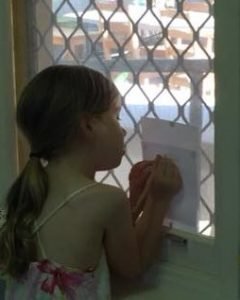
“The Lord is my shepherd, I have everything I need.”
“Thy Kingdom come!”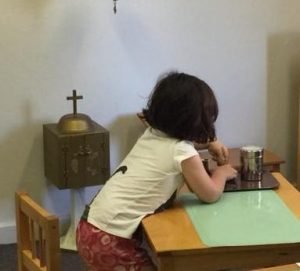
Later when they are a bit older and begin to see how we must work in community to serve the body of Christ, children enter a moral stage of development. Then is the time when children more naturally pray prayers of petition. Until then, let us join with them, sensitive to their needs, in joyful thanks and praise to our God.
by Catechist | 16 Feb 2018 | Lent
Reflections for the Journey
Ash Wednesday

Leaving everything behind, stripped bare of all of the past and, like the legendary phoenix, from the ashes will rise a new beginning, a new life. Our Australian bushland knows this story, it is the story of each new generation, and it is part of God’s plan. We are called to walk through the fire and cover ourselves with ashes, a sigh that we know that we began as a speck and will one day return to the earth in our mortal body. Yet like the seed with so much hidden potential, that requires the heat of the fire to crack open, we too have hope that within us that part that is slowly being formed will seize hold of the potential and rise to new life.
So, we gather and place ash upon our heads and remember we are dust, we are sinners who although undeserving to have Him enter under our roof, know that by His word we are made whole.
The Desert

Walking in the desert it is lonely, peaceful, barren yet full of life. It is where the prophets go to hear the voice of God. It is where Jesus went to prepare for his ministry. It is a place where the interruptions are those forced on us by our own thoughts. The temptations are mostly distractions from our real purpose. The hunger and thirst are nothing compared to our pride and earthly desires for recognition, for love, for possessions and good health. All are mirages when compared with the mission to which we are called; to deny ourselves and come follow Him; to see the place where He lives.
Forty days, a little over a month, seems like a drop in the ocean of our life. Some say that it takes forty days to change a habit. Is this forty days for us to recreate ourselves, to reform who we are, to make ourselves something closer to that which we are called to be?
Lent

Lent means spring, the season of new life of unrestrained growth. We celebrate it in autumn, the season of letting the last season’s growth fall away to prepare the earth for the next season of growth. Both symbolise putting off the old and taking on the new. Both seasons are vital for the survival of the ecosystem. It can be a springboard for us to change, a catalyst for us to take on something we have been holding back from. It can be a time to spring clean our lives in order to make room for The Life.
© 2013 Marie Fernandez
by Catechist | 6 Feb 2018 | Advent, Christmas, Easter, Lent, Liturgical Calendar, Pentecost
Our liturgical cycle refers to the readings and celebrations we have throughout the church year. The word Liturgy means the work of the people. This is the work we do as a community when we come together to celebrate the Mass.
Did you know that prior to the second Vatican Council the Church had only two readings for each Mass (these were a reading from the Epistles and the Gospel, readings from the Old Testament were rarely used), on a one year cycle? The same readings were used each year. Since Vatican II, each Sunday Mass has three readings have been used, one from the Old Testament (except after Easter where NT readings are used), the Second from the New Testament Epistles and the Gospel. These were used over a three year cycle. The intention was to expose the congregation to more of the Biblical texts. The weekday readings would also be expanded to a two year cycle with two readings at each Mass.
To figure out which year we are in, here’s a little trick; if the year is divisible by 3 then you are in year C. The years cycle alphabetically. In Year A the primary Gospel is that of Matthew, year B the Gospel is primarily Mark and year C it is Luke. The Gospel of John is proclaimed on particular Sundays in each of the three years. For the weekdays Year 1 are the odd years, Year 2 the even.
The Liturgical Year begins with the First Sunday of Advent and concludes with the Feast of Christ the King. Like any calendar it celebrates special occasions or feasts and has seasons. The six seasons emphasis different parts of the life of Jesus. They are: Advent, Christmas, Lent, Easter Triduum (three events – Holy Thursday, Good Friday, Easter Sunday), Easter, Ordinary Time. Each season is highlighted by using particular colours.
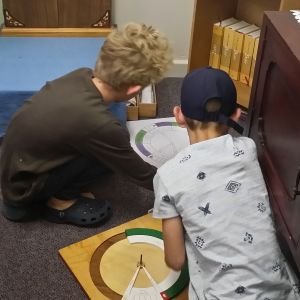
In the atrium of the Catechesis of the Good Shepherd we highlight for the children three major feasts: Easter, Christmas and Pentecost. We celebrate the way God interacts with people through these great events.
We mark the passing of seasons through the use of liturgical colours on our prayer table and in some of the atrium works. We talk about the seasons through the liturgical colours. Purple (used in lent and advent) is for preparing for the feast to come. White, the colour we use at Baptism, the colour of the light, is for the great feasts of celebration (Easter and Christmas). Green, the colour of new leaves of growing things, is for the Ordinary Time, that long time between feasts where thewoders of Jesus sit within us and grow and form us. And red the colour of fire, the flame of Pentecost and the Holy Spirit. One of the songs the children love to sing to hep them remember the colours and what they mean has these words:
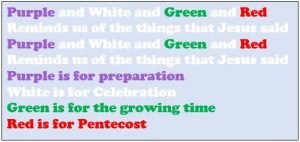
We meditate specifically on the church liturgical cycle using the Liturgical Calendar. The calendar is circular, as it represents that the years continue in a pattern that repeats. The calendar is read in an anticlockwise direction, to remind us that this is not the same time we live in, it is not like a clock, but it is different. It is God’s time.
by Catechist | 9 Jan 2018 | Baptism, Sacraments
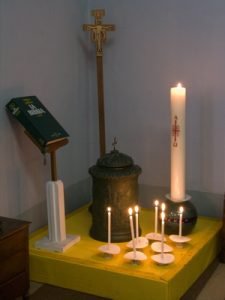 This Sunday we celebrate the Baptism of the Lord. Baptism is the first sacrament of initiation into the church. It marks us as sheep of the Good Shepherd and gives us what we need to follow him and help to build his Kingdom.
This Sunday we celebrate the Baptism of the Lord. Baptism is the first sacrament of initiation into the church. It marks us as sheep of the Good Shepherd and gives us what we need to follow him and help to build his Kingdom.
In the atrium we meditate on the Sacrament of Baptism and the signs and symbols used in this sacrament.
Light
The gift of light was the fist thing that God created. It lights our path and chases away the darkness. In Baptism it is also a sign of the risen Christ who is stronger than death and whose light will never go out. He shares his light with us and asks us to share it with the whole world so that the light will chase away the darkness.
Water
We know that water is necessary for life, without it nothing would grow. It is cleansing and refreshing, calming and exhilarating. We are born in water from our mother’s womb and it is fitting that we are born to life in Christ through the waters of Baptism.
A gesture is made over the water asking for the Holy Spirit to come. When the waters are poured on the one who is Baptised the Holy Spirit fills them with his gifts.
The water is not dripped over the one who is Baptised but poured out in abundance, showing how much God wants us to have His Life in His Kingdom.
Oils
In Baptism we are annointed with two oils.
The Oil of Catechumens, like oil used to strengthen athletes bodies and to heal wounds, this oil prepares us for life as God’s children. It gives us strength to help to bring about God’s Kingdom.
The Oil of Chrism, a sweet smelling oil used to annoint Priest’s Prophets and Kings. The sweet smell reminds us that this gift of the life of Jesus is beautiful and to be shared with others.
The Word
God’s Word is one way God speaks to us. He word guides our lives. At Baptism, His Word is read to encourage us to listen to Him and to be guided by Him.
The Sign of the Cross
Like a brand on a sheep showing who it belongs to, the cross is signed on our bodies to mark us as sheep of the Good Shepherd. A larger cross is placed before us as a shield to protect us throughout our lives.
by Catechist | 9 Jan 2018 | Christmas
The Feast of the Epiphany of the Lord marks the end of the Christmas season. What a wonderful way to finish off this season which we often connect with gift giving! The readings at Mass reflect on the story of wise men coming from the East to come and find the newborn king and do him homage.
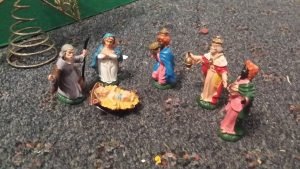
Often, we reflect on these wise men, how did they know? Who were they? Why would they come? How did they feel when they found him in a manger? Did they still want to give their gifts?
Many reflect that the wise men coming from outside of Israel represent that the Messiah was for all people not just the “chosen people”.
In the atrium, we reflect with the youngest children about the wonderous events surrounding the birth of the child promised by the prophets. Isaiah tells us that he will have “the government on his shoulders and his name will be wonderful counselor, mighty God, everlasting father and Prince of peace” (Isaiah 9:6) and the book of Numbers says that a “star will come out of Jacob and a sceptre will rise out of Israel” (Numbers 24:17).
We ponder about who this child is born in a stable to a young mother? Who is he whose birth is announced even in the stars? Who is this child that visitors travel so far to greet?
The wise men or magi had been watching and waiting. They noticed the signs, perhaps before the people of Israel.
We ponder: How did they feel when they finally found him?
As the children get a little older we go deeper.
We often reflect on the plan of God;
“A plan has always existed in the mind of God, the aim of which is to bring humankind to the full enjoyment of God.” (Sofia Cavalletti, History of the Kingdom of God, Part 1, From Creation to Parousia, 1)
We may look at the gifts given to the baby. What kind of gifts do we normally give to newborn babies? Not the gifts given by the magi. What use were gold, frankincense and myrrh to a small child? Could they mean something more?
Did the magi know something more about this child? Did they know who he really was?
Consider gold, a gift fit for a king. What kind of king was this baby? King of what? King of who?
Frankincense, an offering to God. Did they know he was the Son of God?
Myrrh, used to anoint one who dies. A strange gift for someone beginning their life. Perhaps it may mean that this child would die, just like everyone else. He was human like us.
Who was this child? Who did he come for?
by Catechist | 20 Dec 2017 | Catechesis, Formation
Level 2 Part 2
Adult Formation
Monday 15th – Saturday 20th January 2018

Catechesis of the Good Shepherd WA
A Vision for Children
The Catechesis of the Good Shepherd offers Christian formation for children ages 3 through 12. Through this experience, children are helped to form an authentic, faithful relationship with God. The Catechesis is grounded in scriptural and liturgical study framed by Maria Montessori’s principles of education. The children are given the opportunity to hear the Gospel and absorb its message through the use of sensorially rich materials and the work of their hands.
Your Invitation
You are invited to participate in this Level II Part 2 formation, which will be a personal faith enrichment retreat as well as prepare you to work in an atrium with children ages 6 to 9 years old if you choose to.
Course Description
The Level II course continues the themes of the Catechesis of the Good Shepherd begun in Level I formation. It is essential that those taking this course have completed their Level I formation. The objectives of this Level II formation include:
- To explore the religious nature and the developmental plane of the 6 to 9 year old child;
- To continue the presentation of the methodology and guiding principles of the Catechesis of the Good Shepherd, with a focus on moral formation that includes preparation for the sacraments of Eucharist and Reconciliation;
- To broaden the catechist’s ability to observe and learn from children, to listen with children to Scripture, and to deepen the catechist’s enjoyment of God’s presence;
- To offer guidelines and assistance in preparing the atrium environment and in making the catechist’s album and catechetical material;
- To meditate on the biblical and liturgical themes presented to the 6 to 9 year old child.
This course is a spiritual formation experience for adults, as well as instruction in this method of catechesis for children. The pace of the course is retreat-like in keeping with its contemplative nature of the CGS approach. Presentations are given from Scripture and liturgy as they are given to the children. Adults will receive background information on selected themes and will be encouraged to read the core CGS texts throughout the course. Participants who complete this formation will receive a certificate from the Australian Association of the Catechesis of the Good Shepherd.
Other details
Coffee/Tea and snacks will be served during the course hours. We ask participants to bring their own lunch. Be aware in order to fulfill the 45-hour requirement for certification, there may be a few days of working lunches. Tuition for the formation is $350. See booking form for details about payment.
Presenters

Mary Hare, the current President of the Australian Association of the Catechesis of the Good Shepherd. We are very grateful to have Mary join us and share her many years of experience working with children and adults in CGS.

Marie Fernandez, is a catechist from Western Australia who has worked in all levels of CGS. Marie is the current secretary of CGSWA as well as editor of the Green Pastures Australian Journal for CGS.
Location
45 Wellington Road Morley WA 6062
Next door to Infant Jesus Catholic Church, park at rear or in the church carpark.
Phone: 0405 310 197
Email: info@cgswa.org.au
Web: cgswa.org.au
Booking Form
(please email the following details to info@cgswa.org.au)
Participants Name:___________________________________________________________
Address:_______________________________________________________________________
Email:____________________________________________Phone:______________________
Completed L1P1, L1P2, L2P1, L2P2, L3P1, L3P2 (please circle)
Please pay via direct deposit to: Catechesis of the Good Shepherd WA Inc BSB: 086-006 Acct No: 19-562-9916 Amount $350
by Catechist | 30 Nov 2017 | Advent, Atrium, Catechesis, Parousia
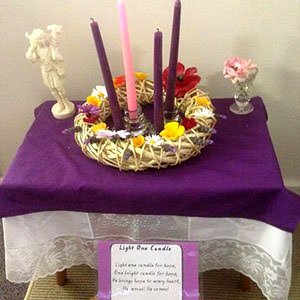
The Atrium in the early church was the place near the church entrance where new believers prepared to be received into the church through the sacraments of initiation.
The atrium in the context of Catechesis of the Good Shepherd is the gathering place; a place to prepare to become full members of the church; the place where the children come to develop a personal relationship with Jesus, the Good Shepherd.
The season of Advent marks the beginning of a new liturgical year. With the children this is celebrated by a procession and a changing of the colours of the prayer table cloth from green to purple. Purple is the colour used in the church for this season. We talk to the children about preparing our hearts to receive Jesus at the great feast of the Nativity.
We often reflect on the sensorial symbols used in the church to alert the children to what they will encounter at Mass; the priest will wear purple as a sign of preparation for the coming of Jesus.
During advent we seek out the signs to help us recognize this coming. We read the prophecies of Isaiah and wonder who is this one who is coming? This child who is called Immanuel – God with us, this child who has been given authority and will be called Mighty God, Wonderful Counsellor, Everlasting Father, Prince of Peace. We ponder about what the great light is that the people who walk in darkness will see.
We then look at the coming of Jesus, how his birth was announced to a young girl in Nazareth. We wonder at how the spirit came upon her and how she was able to respond with a yes to the call to become the tabernacle of the Lord.
We ponder how the secret was passed from God, through an angel first to Mary then to Elizabeth and her unborn child, who recognized Immanuel still being knitted in his mother’s womb.
We imagine how the shepherds felt when the angels told them that the savior had been born. That Mighty God born in a lowly stable, what does this mean? Who will he become??
But Advent is more than reliving the memories of the birth of Christ. It is not a memorial celebration. The word advent comes from the Latin adventus which is the translation of the Greek word Parousia, when Christ will come again.
Are we looking for the signs that the prophets foretold? Are we the people now walking in darkness, will we see the great light? Will we recognize the child born in a stable if he came to our world today? Will he come in power or will he come as before, as one who is little and humble? Are we looking and searching? Are we prepared?
The gospel reading for the first Sunday in advent is taken from Mark 13:33-37 where we are called to keep awake because we do not know the day or the hour of the master’s return. I invite you to read and reflect on these words.
Mark 13:33-37 New Revised Standard Version Catholic Edition (NRSVCE)
33 Beware, keep alert;[a] for you do not know when the time will come. 34 It is like a man going on a journey, when he leaves home and puts his slaves in charge, each with his work, and commands the doorkeeper to be on the watch. 35 Therefore, keep awake—for you do not know when the master of the house will come, in the evening, or at midnight, or at cockcrow, or at dawn, 36 or else he may find you asleep when he comes suddenly. 37 And what I say to you I say to all: Keep awake.”
Footnotes: Mark 13:33 Other ancient authorities add and pray
(source: https://www.biblegateway.com/passage/?search=Mark+13%3A33-37&version=NRSVCE)
Are you ready?
by Catechist | 22 Nov 2017 | Catechesis, Uncategorized
How do we introduce Christ the King in the atrium?
The method we use with the little children in the Catechesis of the Good Shepherd is to wonder about what God is telling us in his word and to look at signs and symbols for their hidden secrets.
Pope Pius XI established the Feast of Christ the King in 1925. The Pope wrote about his reasons for instituting this feast day in his encyclical, Quas Primas[i]. Some of the things he refers to seem to be echoed in the things we face today in a world that is rapidly turning to serving themselves and away from Christ.
A King implies there is a Kingdom. We learn about his kingdom through the parables. Jesus reveals to us the secrets of the kingdom of God but in a way where we have to pon der and seek. The kingdom of God is like a mustard seed[ii], it is like a precious pearl[iii], like a treasure hidden in a field[iv], like yeast in bread[v]. How do these parables help us to understand what God’s kingdom is like? It is a mystery we can ponder for a long time. Something so small that grows to something so big. Something so precious that we look all of our lives to find it, or perhaps stumble across it when we are on our way to do other things. What is God’s kingdom? During advent we meditate on in the atrium is about the one who is to come. One who will rule:
der and seek. The kingdom of God is like a mustard seed[ii], it is like a precious pearl[iii], like a treasure hidden in a field[iv], like yeast in bread[v]. How do these parables help us to understand what God’s kingdom is like? It is a mystery we can ponder for a long time. Something so small that grows to something so big. Something so precious that we look all of our lives to find it, or perhaps stumble across it when we are on our way to do other things. What is God’s kingdom? During advent we meditate on in the atrium is about the one who is to come. One who will rule:
I see him, but not now; I behold him, but not near; A star shall come forth from Jacob, A scepter shall rise from Israel [vi]
One who will have powerful names:
For a child will be born to us, a son will be given to us; And the government will rest on His shoulders; And His name will be called Wonderful Counselor, Mighty God, Eternal Father, Prince of Peace[vii].
With some of the older children we meditate on our role in the kingdom. We ask questions of ourselves. How can I bring his kingdom closer? What can I do today? How do I live and continue to bring about God’s Plan of bringing all people to life in his kingdom? Each time we pray the Our Father we say the words:
“Thy kingdom come, Thy will be done[viii]”.
Are we aware of what we are asking for? Is it something we truly embrace? It makes me reflect on my own life. Am I continuing the help God’s kingdom to come now, here, in my everyday thoughts and action? Am I longing 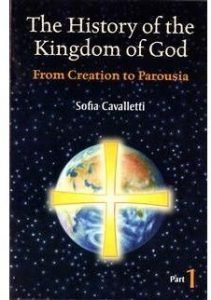 for Parousia when God will be all in all[ix] and his kingdom will have no end[x]? Sofia Cavalletti in her book The History of God From Creation to Parousia[xi] says
for Parousia when God will be all in all[ix] and his kingdom will have no end[x]? Sofia Cavalletti in her book The History of God From Creation to Parousia[xi] says
“Thus, the history continues straining toward a hope: the salvation of all people and the expansion of the covenant to the “ends of the earth,” when the saved person will carry with him or her the entire universe, “which has been groaning in labor pains until now” (Romans 8:22). Indeed, the redemption of the universe is connected to human redemption. Just as the earth was cursed because of humankind’s sin, so, too, it will be restored and redeemed by the influence – positive this time – that redeemed human beings exercise upon it[xii]. Thus, all things will be recapitulated in Christ, who will reinstate the kingdom of God, and his kingdom will have no end.”
____________________________________________________________________________________________________
- [i] http://w2.vatican.va/content/pius-xi/en/encyclicals/documents/hf_p-xi_enc_11121925_quas-primas.html
- [ii] Matthew 13:31
- [iii] Matthew 13:45
- [iv] Matthew 13:44
- [v] Matthew 13:33
- [vi] Numbers 24:17
- [vii] Isaiah 9:6
- [viii] Matthew 6:10
- [ix] 1 Corinthinans 15:28
- [x] Luke 1:33
- [xi] Cavalletti, S, The History of the Kingdom of God Part 2 From Creation to Parousia. Liturgy Training Publications, Chicago IL, 2012, page 185.
- [xii] Lyonnet, S, La storia della salvezza nella Lettera ai Romani, Napoli, 1966, page 221.
 When preparing to serve the needs of the children in the atrium, I find it helpful to remind myself of my role and task in this process. As each Catechist undergoes formation it can be a massive amount of information being received in a relatively short time. Much of this is also changing the way we have viewed working with children in our past.
When preparing to serve the needs of the children in the atrium, I find it helpful to remind myself of my role and task in this process. As each Catechist undergoes formation it can be a massive amount of information being received in a relatively short time. Much of this is also changing the way we have viewed working with children in our past.


 The resurrection is something we recall all the time in the atrium. When we light a candle, at the altar table, in the Baptism corner, during communal prayer, we recall the light of the risen Christ, the light that is stronger than death.
The resurrection is something we recall all the time in the atrium. When we light a candle, at the altar table, in the Baptism corner, during communal prayer, we recall the light of the risen Christ, the light that is stronger than death.


 lts. It is spontaneous and includes silence and reflection. Consider a very small child silently watching an insect in the garden or concentrating intently on some task they are doing. This silent contemplation is a form of prayer. Very young children express their prayer in the joy of experiencing everything as new and wonderful. Their spoken prayer is that of thanksgiving and joy.
lts. It is spontaneous and includes silence and reflection. Consider a very small child silently watching an insect in the garden or concentrating intently on some task they are doing. This silent contemplation is a form of prayer. Very young children express their prayer in the joy of experiencing everything as new and wonderful. Their spoken prayer is that of thanksgiving and joy.







 This Sunday we celebrate the Baptism of the Lord. Baptism is the first sacrament of initiation into the church. It marks us as sheep of the Good Shepherd and gives us what we need to follow him and help to build his Kingdom.
This Sunday we celebrate the Baptism of the Lord. Baptism is the first sacrament of initiation into the church. It marks us as sheep of the Good Shepherd and gives us what we need to follow him and help to build his Kingdom.






 der and seek. The kingdom of God is like a mustard seed
der and seek. The kingdom of God is like a mustard seed for Parousia when God will be all in all
for Parousia when God will be all in all